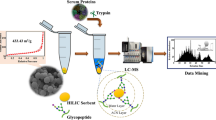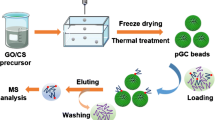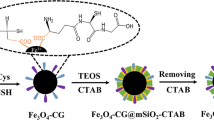Abstract
A hydrophilic interaction liquid chromatography (HILIC) material with application in glycoproteomics was obtained by sequential deposition of polyethyleneimine (PEI) and hyaluronic acid (HA) on a negatively charged substrate by means of electrostatic self-assembly. This kind of surface modification endows the material with excellent hydrophilicity and warrants efficient glycopeptides enrichment. The feasibility of this enrichment was verified by using dendritic mesoporous silica nanoparticles (DMSNs) and magnetic graphene oxide (MagG) as negatively charged substrates for PEI and HA adhesion. The two final products (DMSNs@PEI@HA and MagG@PEI@HA) exhibit high enrichment selectivity (molar ratios of IgG and BSA digests = 1:500 and 1:1000), sensitivity (detection limit, 2 fmol/μL), recovery (>90%) and enrichment capacity (300 mg/g). When using DMSNs@PEI@HA, 419 N-glycopeptides derived from 105 glycoproteins were identified. When using MagG@PEI@HA, 376 N-glycopeptides derived from 102 glycoproteins were identified, both from a 2 μL serum sample. This is better than by methods described in previous reports.

Schematic representation of hydrophilic modification of negatively charged nanomaterial substrates by electrostatic self-assembly techniques to obtain hydrophilic interaction liquid chromatography (HILIC) materials for enrichment of N-glycopeptides.






Similar content being viewed by others
References
Hart GW, Copeland RJ (2010) Glycomics hits the big time. Cell 143(5):672–676
Lowe JB (2001) Glycosylation, immunity, and autoimmunity. Cell 104(6):809–812
Ohtsubo K, Marth JD (2006) Glycosylation in cellular mechanisms of health and disease. Cell 126(5):855–867
Helenius A, Aebi M (2001) Intracellular functions of N-linked glycans. Science 291(5512):2364–2369
Dosekova E, Filip J, Bertok T, Both P, Kasak P, Tkac J (2017) Nanotechnology in Glycomics: applications in diagnostics, therapy, imaging, and separation processes. Med Res Rev 37(3):514–626
Hu Y, Xia Q, Huang W, Hou X, Tian M (2017) Boronate-modified hollow molecularly imprinted polymers for selective enrichment of glycosides. Microchim Acta 185(1):46
Liu CM, Li YM, Semenov M, Han C, Baeg GH, Tan Y, Zhang ZH, Lin XH, He X (2002) Control of beta-catenin phosphorylation/degradation by a dual-kinase mechanism. Cell 108(6):837–847
Ludwig JA, Weinstein JN (2005) Biomarkers in cancer staging, prognosis and treatment selection. Nat Rev Cancer 5(11):845–856
Jin S, Liu L, Zhou P (2018) Amorphous titania modified with boric acid for selective capture of glycoproteins. Microchim Acta 185(6):308
Sun N, Wang J, Yao J, Chen H, Deng C (2019) Magnetite nanoparticles coated with mercaptosuccinic acid-modified mesoporous titania as a hydrophilic sorbent for glycopeptides and phosphopeptides prior to their quantitation by LC-MS/MS. Microchim Acta 186(3):159
Wang J, Wang Z, Sun N, Deng C (2019) Immobilization of titanium dioxide/ions on magnetic microspheres for enhanced recognition and extraction of mono- and multi-phosphopeptides. Microchim Acta 186(4):236
Zhang K, Hu D, Deng S, Han M, Wang X, Liu H, Liu Y, Xie M (2019) Phytic acid functionalized Fe3O4 nanoparticles loaded with Ti(IV) ions for phosphopeptide enrichment in mass spectrometric analysis. Microchim Acta 186(2):68
Dominguez-Vega E, Tengattini S, Peintner C, van Angeren J, Temporini C, Haselberg R, Massolini G, Somsen GW (2018) High-resolution glycoform profiling of intact therapeutic proteins by hydrophilic interaction chromatography-mass spectrometry. Talanta 184:375–381
Kozlik P, Goldman R, Sanda M (2018) Hydrophilic interaction liquid chromatography in the separation of glycopeptides and their isomers. Anal Bioanal Chem 410(20):5001–5008
Bi CF, Zhao YR, Shen LJ, Zhang K, He XW, Chen LX, Zhang YK (2015) Click synthesis of hydrophilic maltose-functionalized Iron oxide magnetic nanoparticles based on dopamine anchors for highly selective enrichment of Glycopeptides. ACS Appl Mater Interfaces 7(44):24670–24678
Feng XY, Deng CH, Gao MX, Yan GQ, Zhang XM (2018) Novel synthesis of glucose functionalized magnetic graphene hydrophilic nanocomposites via facile thiolation for high-efficient enrichment of glycopeptides. Talanta 179:377–385
Shao WY, Liu JX, Yang KG, Liang Y, Weng YJ, Li SW, Liang Z, Zhang LH, Zhang YK (2016) Hydrogen-bond interaction assisted branched copolymer HILIC material for separation and N-glycopeptides enrichment. Talanta 158:361–367
Li JN, Wang FJ, Wan H, Liu J, Liu ZY, Cheng K, Zou HF (2015) Magnetic nanoparticles coated with maltose-functionalized polyethyleneimine for highly efficient enrichment of N-glycopeptides. J Chromatogr A 1425:213–220
Jin T, Xiong ZC, Zhu X, Mehio N, Chen YJ, Hu J, Zhang WB, Zou HF, Liu HL, Dai S (2015) Template-free synthesis of mesoporous polymers for highly selective enrichment of Glycopeptides. ACS Macro Lett 4(5):570–574
Wang YL, Liang S, Chen BD, Guo FF, Yu SL, Tang YL (2013) Synergistic removal of Pb(II), cd(II) and humic acid by Fe3O4@mesoporous silica-graphene oxide composites. PLoS One 8(6):8
Jiang B, Wu Q, Deng N, Chen YB, Zhang LH, Liang Z, Zhang YK (2016) Hydrophilic GO/Fe3O4/au/PEG nanocomposites for highly selective enrichment of glycopeptides. Nanoscale 8(9):4894–4897
Hong YY, Yao YT, Zhao HL, Sheng QY, Ye ML, Yu CZ, Lan MB (2018) Dendritic mesoporous silica nanoparticles with abundant Ti4+ for Phosphopeptide enrichment from Cancer cells with 96% specificity. Anal Chem 90(12):7617–7625
Hong YY, Zhao H, Pu CL, Zhan QL, Sheng QY, Lan MB (2018) Hydrophilic Phytic acid-coated magnetic graphene for titanium(IV) immobilization as a novel hydrophilic interaction liquid chromatography-immobilized metal affinity chromatography platform for Glyco- and Phosphopeptide enrichment with controllable selectivity. Anal Chem 90(18):11008–11015
Pu C, Zhao H, Hong Y, Zhan Q, Lan M (2019) Elution-free ultra-sensitive enrichment for glycopeptides analyses: using a degradable, post-modified Ce-metal-organic framework. Anal Chim Acta 1045:123–131
Li XT, Xue M, Raabe OG, Aaron HL, Eisen EA, Evans JE, Hayes FA, Inaga S, Tagmount A, Takeuchi M, Vulpe C, Zink JI, Risbud SH, Pinkerton KE (2015) Aerosol droplet delivery of mesoporous silica nanoparticles: a strategy for respiratory-based therapeutics. Nanomed-Nanotechnol Biol Med 11(6):1377–1385
Tiwari S, Bahadur P (2019) Modified hyaluronic acid based materials for biomedical applications. Int J Biol Macromol 121:556–571
Zhang M, Zhao X, Fang Z, Niu Y, Lou J, Wu Y, Zou S, Xia S, Sun M, Du F (2017) Fabrication of HA/PEI-functionalized carbon dots for tumor targeting, intracellular imaging and gene delivery. RSC Adv 7(6):3369–3375
Sun NR, Wang JW, Yao JZ, Deng CH (2017) Hydrophilic mesoporous silica materials for highly specific enrichment of N-linked Glycopeptide. Anal Chem 89(3):1764–1771
Bi C, Liang Y, Shen L, Tian S, Zhang K, Li Y, He X, Chen L, Zhang Y (2018) Maltose-functionalized hydrophilic magnetic nanoparticles with polymer brushes for highly selective enrichment of N-linked Glycopeptides. ACS Omega 3(2):1572–1580
Huan WW, Zhang JS, Qin H, Huan F, Wang BC, Wu MJ, Li J (2019) A magnetic nanofiber-based zwitterionic hydrophilic material for the selective capture and identification of glycopeptides. Nanoscale 11(22):10952–10960
Chen YJ, Xiong ZC, Zhang LY, Zhao JY, Zhang QQ, Peng L, Zhang WB, Ye ML, Zou HF (2015) Facile synthesis of zwitterionic polymer-coated core-shell magnetic nanoparticles for highly specific capture of N-linked glycopeptides. Nanoscale 7(7):3100–3108
Zhang QQ, Huang YY, Jiang BY, Hu YJ, Xie JJ, Gao X, Jia B, Shen HL, Zhang WJ, Yang PY (2018) In situ synthesis of magnetic mesoporous phenolic resin for the selective enrichment of Glycopeptides. Anal Chem 90(12):7357–7363
Zhang YW, Li Z, Zhao Q, Zhou YL, Liu HW, Zhang XX (2014) A facilely synthesized amino-functionalized metal-organic framework for highly specific and efficient enrichment of glycopeptides. Chem Commun 50(78):11504–11506
Li YL, Wang JW, Sun NR, Deng CH (2017) Glucose-6-phosphate-functionalized magnetic microsphere as novel hydrophilic probe for specific capture of N-linked Glycopeptides. Anal Chem 89(20):11151–11158
Liu QJ, Xie YQ, Deng CH, Lie Y (2017) One-step synthesis of carboxyl-functionalized metal-organic framework with binary ligands for highly selective enrichment of N-linked glycopeptides. Talanta 175:477–482
Acknowledgements
This work was supported by Natural Science Foundation of Shanghai (No. 19ZR1412000) and the Fundamental Research Funds for the Central Universities (No. 50321101917022).
Author information
Authors and Affiliations
Corresponding author
Ethics declarations
The author(s) declare that they have no competing interests.
Additional information
Publisher’s note
Springer Nature remains neutral with regard to jurisdictional claims in published maps and institutional affiliations.
Electronic supplementary material
ESM 1
(PDF 2020 kb)
Rights and permissions
About this article
Cite this article
Zhan, Q., Zhao, H., Hong, Y. et al. Preparation of a hydrophilic interaction liquid chromatography material by sequential electrostatic deposition of layers of polyethyleneimine and hyaluronic acid for enrichment of glycopeptides. Microchim Acta 186, 600 (2019). https://doi.org/10.1007/s00604-019-3712-2
Received:
Accepted:
Published:
DOI: https://doi.org/10.1007/s00604-019-3712-2




